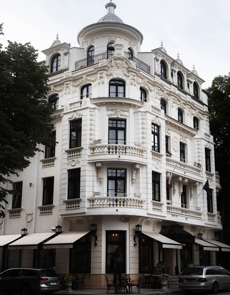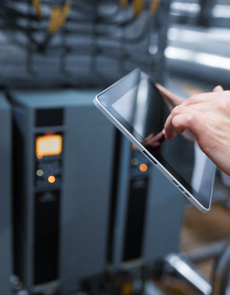Types of facility management software - which one is right for you?
As a business owner, you’ll be all too aware of the importance of efficient facility management in ensuring the smooth operation and optimal performance of your organisation.
Facility management software can really be a game changer, but with so many options open to you, how do you know which will be the right fit for your business? There’s no one definitive answer to this question; instead, it’s important to consider your business needs, and how these can be met by the different types of software available on the market. That process starts with understanding what’s out there, and what it can do for you.
This article will offer a comparison between CAFM (Computer Aided Facility Management) vs CMMS (Computerised Maintenance Management System), discussing their pros and cons to help you make an informed decision.
Different types of facilities management software
When you’re choosing the right facilities management software for your business, you need to consider your specific needs, budget constraints, scalability requirements and the level of integration with any existing systems you may currently be running.
It’s also important not to forget that user training and ongoing support are crucial to the success of whichever software solution you decide to go with.
Facilities management software comes in various shapes and sizes, many of which are tailored to specific needs and industries.
Computer-Aided Facility Management (CAFM)
CAFM provides a centralised data management system, making it easy to access facility information. This system is perfect for hospitality businesses such as hotels looking to streamline their hotel maintenance, and restaurants looking to maintain their dining space. It's also useful for businesses who operate office space. This allows efficient space planning, streamlined maintenance processes, improved asset tracking and inventory management, as well as enhanced reporting and data analysis. CAFM requires ongoing user training to maximise its potential.
Computerised Maintenance Management System (CMMS)
CMMS provides more maintenance-based scheduling and planning.
It offers enhanced equipment and asset tracking, improved compliance documentation and better resource and cost management. Good for reducing equipment downtime.
CMMS may not cover everything you need as it focuses on maintenance and may require more integration with existing systems to get the most from it.
Integrated Workplace Management System (IWMS)
IWMS is a comprehensive solution that covers many aspects of facility management.
IWMS enhances data visibility and reporting but comes with higher upfront cost and can be trickier to integrate with existing systems, meaning it takes longer to implement.
Energy Management System (EMS)
EMS allows for monitoring and analysis of energy consumption, allowing businesses to proactively identify and implement energy saving solutions.
EMS is an overall limited system which requires additional resources to keep up with data maintenance and the data it gathers may need expert analysis.
Space Management Solutions
Space Management Solutions allow you to optimise space and allocate resources efficiently. They offer visual planning tools for laying out space and planning occupancy etc.
They’re limited in scope as they focus on space related functions rather than whole facility management.
Asset Management Solutions
These are comprehensive asset tracking solutions with lifecycle management features, which can improve maintenance planning and reduce downtime.
They often don’t cover any other facility management aspects and require significant data input, leading to a lot of effort in set up and ongoing training and support for users.
Integrated Service Management (ISM)
ISM’s improve response times for centralised service requests. They allow for much more efficient use of resources but implementation is often complex and time consuming.
They often don’t cover any other facility management aspects and require integration with other systems for optimal effectiveness.
Vendor Management Solutions
Offers enhanced vendor compliance and risk management with insights for vendor selection and cost. Improves collaboration and communication with vendors.
Like a lot of these single solution offerings they don’t cover any other facility management aspects and require integration with other systems for optimal effectiveness.
Health and Safety Management Solutions
H&S solutions offer comprehensive tracking of incidents, inspections and compliance for health and safety, often with real time alerts.
Again, concentrates on a single aspect of overall facilities management.
Lease Management Solutions
For tracking of lease agreements. Improves efficiency of managing terms, renewals, expirations etc and streamlines rent payments and financial reporting.
And once again, this software is single task specific, so limited in scope.
Sustainability and Environmental Solutions
Helps you to improve sustainability and reduce environmental impact.
For optimal effectiveness needs integrating with multiple other systems such as energy management systems.
As you can see, there is so much to look at when it comes to choosing the most suitable solution for your business - however the two most rounded solutions are CAFM and CMMS. So, let's look a bit closer at those.
CAFM vs CMMS
While the main aim of both of these systems is to improve facility management, they differ quite significantly in their functionality.
Computerised Maintenance Management Systems (CMMS) are primarily maintenance focused, and are designed to streamline all maintenance tasks.
They allow you to carry out a range of tasks such as work order tracking, scheduling maintenance and asset management.
This kind of system is ideally suited to businesses with a lot of equipment use that want to prioritise preventative maintenance to reduce downtime such as manufacturing, energy and utilities companies.
Computer Aided Facilities Management (CAFM), on the other hand, provides a more comprehensive end-to-end solution that goes beyond maintenance to include many of the features offered by the separate systems mentioned earlier; this includes functionality to help with space management, resource planning and lease management.
CAFM software is great for businesses that want an all round solution to optimise space and resource allocation, ideal for hospitality industries and corporate offices.
The differences between the two can be broken down into a few sections that may make it easier to decide which would be best suited to your industry:
Range of features
- CAFM covers the broader spectrum of facility management, including space, asset, and move planning and management.
- CMMS is focused on maintenance tasks. So things like work orders, preventative maintenance and parts management etc.
Suitability
- CAFM is a better fit for businesses requiring detailed space and resource management, such as offices and hotels.
- CMMS is suited to asset-intensive industries, where the reliability of your equipment is of paramount importance.
Complexity
- CAFM does tend to be a little more complex due to its more extensive range of features; this means it may require more comprehensive training for users.
- CMMS is in the most part more straightforward, as its primary focus is on maintenance related tasks.
Integration with existing systems
- CAFM integrates with various systems such as building management and HR software.
- CMMS integrates with other maintenance related systems such as predictive maintenance sensors.
How to choose the right facilities management software for your business
As we’ve already mentioned, deciding on the right facilities management software for you involves taking a lot into consideration.
Here’re what we think are the key steps to guide your decision:
Assess your requirements
Identify your specific challenges and the goals you want the software to help you achieve. Take into consideration all of the factors such as asset management, space utilisation, resource planning etc.
Industry fit
Determine if your business is asset intensive and would benefit from CMMS, or is it more likely to need comprehensive space management and planning like CAFM offers?
Scalability
Consider the future growth of your business and choose a software solution that will accommodate your evolving needs.
Ease of use
Look at how easy the software will be for your team to use, taking things like the user interface into consideration.
Integration
Will the new facilities management software integrate smoothly with your existing systems?
Budget
You will want to invest in the most reliable software, but you should also consider the costs associated including licensing, implementation and ongoing training and support.
You can read a more detailed article on which is the best CAFM for use in the hospitality industry here.
What next?
Selecting the right facility management software is crucial in optimising your businesses performance and resource utilisation. Carefully assess your needs, compare and contrast features of the various solutions and choose the one that best aligns with your business goals.
Facility management software comes in all shapes and sizes, with CAFM and CMMS being the primary ones, so remember there is no “one size fits all” solution; what works for one business may be unsuitable for another.
CAFM offers a comprehensive solution for space planning, asset management and resource allocation, while CMMS focuses on maintenance tasks.
Consider your specific requirements when conducting thorough research so that you can make an informed decision that will provide benefits to your business in the long run.
This means looking at your industry, business needs, scalability, integration and budget and remember the best fit may vary for different businesses, so take the time to make an informed decision that will benefit your business now and in the future.
Get effective oversight and control across all your sites with our property maintenance system
Related reading
View our resources to support you with facility management




